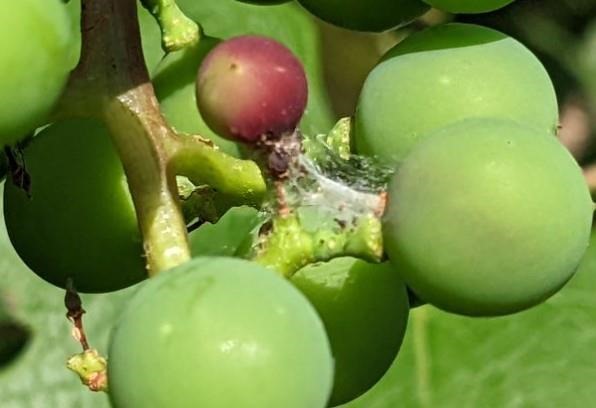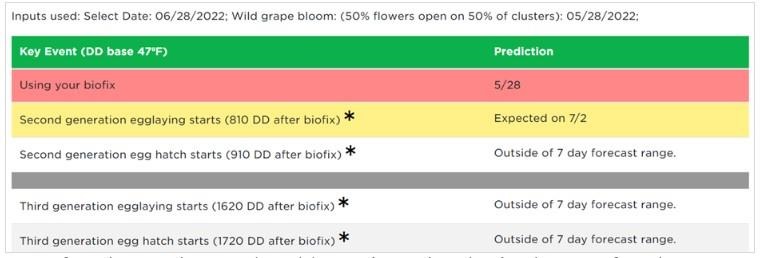By Rufus Isaacs and Jacquelyn Perkins

Photo 1. A red grape berry with webbing, indicating infestation by a first-generation grape berry moth larva.
Grape berry moth (GBM) moths have been trapped throughout June in southwest Michigan, and trap catch is starting to tail off as first generation flight wraps up. These are the male moths caught in traps, but it is the female moths that lay eggs and the results of their activity has been seen in the last few weeks as webbing and berry feeding has been observed during the bloom and post-bloom period. Scouting in vineyards in the last few days in Berrien and Van Buren counties indicate a few red patches on developing grapes (Photo 1), which is the distinctive symptom of a GBM larva entering a berry. In most cases where we looked, these berries did not have a live larva inside, indicating that the post-bloom insecticide applications had stopped further development.
As we move into July, the second generation of GBM is on the horizon. Michigan State University Enviroweather’s degree day model indicates that the start of the second generation egg laying will begin on July 2 in Lawton, Michigan, based on a May 28 biofix of wild grape bloom. For the Southwest Michigan Research and Extension Center (SWMREC), with a May 26 biofix, the start of egg laying is predicted for July 1. The date should be adjusted based on your own location and wild grape bloom timing.
It is important to highlight that this is only the predicted start of egg laying of this generation, and protection through July is important at high risk sites where GBM is a recurrent pest. To achieve this, two applications may be needed. The first should be timed based on the degree day model, with consideration of the product being used. For insecticides that are active on eggs (e.g., Intrepid, Intrepid Edge) they should be applied at this timing. For broad spectrum insecticides such as the various pyrethroids, Imidan, Altacor, Verdepryn, etc., those should be applied at 910 growing degree days (GDD), which aligns more with egg hatch of this pest. For the Lawton region, this should be at July 7-9, but checking the model again next week will be useful to pinpoint that timing based on your location, wild grape biofix, and nearest weather station.
 Output from the grape berry moth model on Enviroweather, showing the output from the Lawton weather station using a May 28 biofix date. This highlights the START of the second generation egg laying on July 2.
Output from the grape berry moth model on Enviroweather, showing the output from the Lawton weather station using a May 28 biofix date. This highlights the START of the second generation egg laying on July 2.Most of the effective insecticides provide seven to 14 days residual activity, but egg laying by the second generation will last throughout July. So, the applications made at the start of July will not cover the whole generation. In high pressure sites where GBM has been a persistent pest, follow-up spray is needed to protect berries from infestation, since later in July the pressure will likely be higher. In vineyards where GBM has been a challenge to control, this middle to late July timed spray is also important for continued control of this pest’s second generation.
As we move through the summer, egg laying by the third generation will likely be starting in mid-August, with continued need for control toward harvest. Scouting vineyards through the rest of the summer can indicate where spray programs are remaining effective and where more protection is needed. The Michigan State University Extension grape team will continue to monitor this and report in our weekly scouting reports.
Source : msu.edu